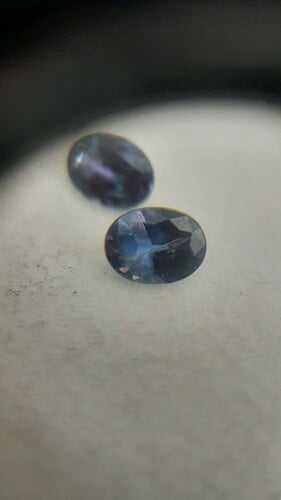i found some alexandrite that have an intresting color change from a greenish blue to a purplish color. it has what seems to be crachs inside, possibly inclusion, and I dont know how i can tell if its natrual or lab. my refractroeter says it is indeed chrysoberyl. Anyone able to save me the 70$ that i can not afford for testing?
You can search on line for sites which give pictures of inclusions in natural and synthetic gems…if you have a loupe, you may be able to determine if the inclusions indicate natural or synthetic. -royjohn
most likely synthetic.
Yeah, you can try your best to take some inclusions images within this gem.
i have tried that. i have searched many places, and asked more then one community before asking here
From gemdat.org:
Synthetic alexandrite: Colour change - daylight: green to blue-green; incandescent light: red to violet-red. Transparent; Hardness 8.5; RI 1.740 - 1.756; Birefringence 0.007 - 0.010; Biaxial/+; SG 3.70 - 3.72; Pleochroism: red/orange-yellow/green; Inclusions: Flux method: flux and crucible (platinum) residues; Pulling method: slightly curved growth lines, black bubble-like inclusions; Hydrothermal method: swirl-like growth inhomogeneties, dark bubble-like residues, flat liquid inclusions; Fluorescence: SW and LW red - Gemmological Tables, Ulrich Henn and Claudio C. Milisenda, 2004, p 25
and:
Inclusions in Alexandrite
Mica platelets, apatite, rutile, healing cracks, multi-phase inclusions, hollow tubes - Gemmological Tables, Ulrich Henn and Claudio C. Milisenda, 2004, p 25
If you search for the names of the synthetics, you should be able to find pictures of the various inclusions by name. Another “tell” is that the color change of the synthetics tends to be “too good to be true” compared to the actual color change of natural alex.
You really will need to do some digging around to find what you seek, but it is there on the Net…-royjohn
Here is a page with links to pulled sythetic alexandrite detection and also flux melt…
https://www.yourgemologist.com/labcreatedandtreatedgemstones.html
This took all of a minute to find once the proper search words were used…
-royjohn
There is only one thing you can do, send it to GIA to have it tested. If you have a stone potentially worth several thousand dollars, you don’t have the money for GIA to look at it? How much did you pay for that stone? If the deal was for several hundred dollars it is not real. If you paid several thousand you can feel better, but should have required the certificate from GIA prior to purchasing. It is always an option for a buyer of one of my stones to ask for a GIA certificate. They have to pay for it, but I have, and am happy to do it for them.
i bought a display case with a range of unmarkewd stones in it, from peridot ranging toi 10 ct, a 18 ct blue topaz, some 4 ct rubies that were translucent, indicolite tourmaline. technically i didnt even buy them. lady gave it to me, something she had inherited, for a custom jewelry piece. so no i really dont have the money to test them. but they do not have the same qualities that my other lab growns have. like any time my scope light hits those they turn red.
You don’t always have to send it to a laboratory-- a qualified Gemologist/Appraiser in your area will be able to determine origin inasmuch as natural vs synthetic, far more quickly than sending to a lab and for less money. The first rule of gemology is “NEVER sight identify,” and I will add that it is impossible to identify from a photograph online. But, with things like inclusions and striae, etc, microscopic evidence will point to one direction or the other.
there is no one in my area worth much in the identification area. this is why I have been learning it all myself. everyone around here has been “I can send it to the lab for you”, for 80$ more then it would cost me to do so. I can confirm it is chrysoberyl, but i dont have a microscope. at 120x, im not seeing striations, but it has fissures. also, the way it reacts under diffrent light sources. I wish i could get a 120x picture.
There are phone apps you download that may help you take some better quality pictures.


